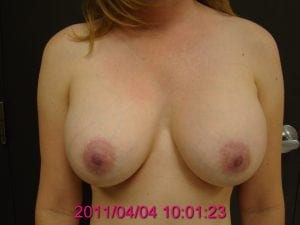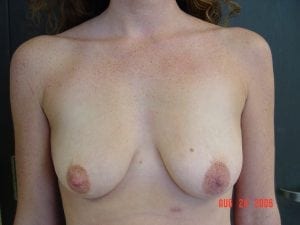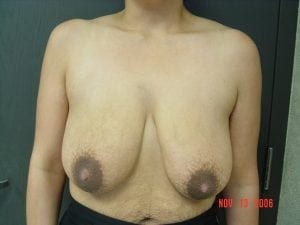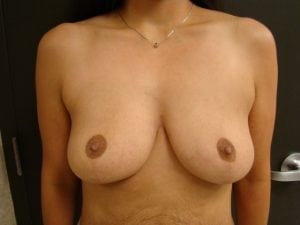Posted September 27, 2011 in Body, Home
In an ideal world, breast augmentation alone would lift sagging breasts. In the real world, it doesn’t. For a discussion of whether you would be better off with implants alone versus implants with a lift, please see our article.
Assuming that you are interested in mastopexy(breast lift) in conjunction with breast enlargement, there are four potential incision choices:
1. Crescent mastopexy
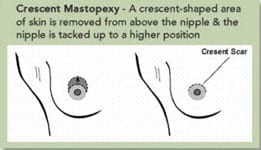
Advantages: Small scar along the upper half of the areola (pigmented tissue surrounding the nipple).
Disadvantages: Minimal degree of lift, may stretch and distort the areola.
Bottom line: I rarely, if ever, recommend this technique.
2. Periareolar (donut) mastopexy
- Before

- After

Periareolar mastopexy with breast implants
Advantages: Small scar around the entire areolar border, may reduce areolar size.
Disadvantages: Mild degree of lift, long-term risk of areolar stretching (especially if an aggressive degree of lifting is attempted).
Bottom line: Useful in carefully selected patients who are interested in lifting the nipple areolae while reducing areolar size.
3. Vertical (lollipop) mastopexy
- Before

- After

Vertical mastopexy with Breast implants
Advantages: reliably lifts most breasts and nipple-areolae, helpful in lifting asymmetric breasts, reliably reduces areolar diameter
Disadvantages: Larger scar (vertical lower breast scar in addition to periareolar scar).
Bottom line: I use this technique for most augmentation mastopexies. In most women, the advantage of improved breast contour outweighs the disadvantage of a vertical scar.
4. Inverted-T (anchor) mastopexy
- Before

- After

Inverted-T mastopexy (without implants)
Advantages: reliably lifts even the saggiest breasts
Disadvantages: Largest scar (horizontal scar in breast crease, vertical lower breast scar, and periareolar scar). Larger risk of delayed wound healing, which can endanger underlying implants.
Bottom line: I use this technique for some breast lifts (without implants) and most breast reductions. Unlike many surgeons, I do not typically use the full anchor incision for simulataneous augmentation and mastopexy.
Here’s a brief summary of my usual recommendations:
Degree of sagging Recommendation
Minimal Breast implants alone
Mild Periareolar (donut)mastopexy or breast implants alone
Moderate Vertical (lollipop) mastopexy
Severe Inverted-T (anchor) mastopexy
There is no perfect technique that suits all women and all breasts. In carefully selected patients, however, the combination of breast augmentation and breast lift may lead to a far better result than either operation performed alone.
